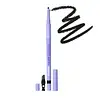What's inside
What's inside
 Key Ingredients
Key Ingredients

 Benefits
Benefits

No benefits
 Concerns
Concerns

 Ingredients Side-by-side
Ingredients Side-by-side

Trimethylsiloxysilicate
EmollientHydrogenated Polyisobutene
EmollientSynthetic Wax
AbrasiveHydrogenated Poly(C6-14 Olefin)
EmollientHydrogenated Polydecene
EmollientMica
Cosmetic ColorantSilica Silylate
EmollientPolybutene
Sodium Hyaluronate
HumectantEthylhexyl Palmitate
EmollientCopernicia Cerifera Wax
Trihydroxystearin
Skin ConditioningPentaerythrityl Tetra-Di-T-Butyl Hydroxyhydrocinnamate
AntioxidantEthylene/Propylene Copolymer
AbrasivePhenoxyethanol
PreservativeCI 77499
Cosmetic ColorantCI 77510
Cosmetic ColorantTrimethylsiloxysilicate, Hydrogenated Polyisobutene, Synthetic Wax, Hydrogenated Poly(C6-14 Olefin), Hydrogenated Polydecene, Mica, Silica Silylate, Polybutene, Sodium Hyaluronate, Ethylhexyl Palmitate, Copernicia Cerifera Wax, Trihydroxystearin, Pentaerythrityl Tetra-Di-T-Butyl Hydroxyhydrocinnamate, Ethylene/Propylene Copolymer, Phenoxyethanol, CI 77499, CI 77510
 Reviews
Reviews

Ingredients Explained
These ingredients are found in both products.
Ingredients higher up in an ingredient list are typically present in a larger amount.
Ci 77499 is also hydrated iron III oxide. It is created from mixing red and black iron oxides. This helps give shades of darkness to a product.
Iron III oxides are classified as inorganic chemicals for coloring.
Mica is a naturally occurring mineral used to add shimmer and color in cosmetics. It can also help improve the texture of a product or give it an opaque, white/silver color.
Serecite is the name for very fine but ragged grains of mica.
This ingredient is often coated with metal oxides like titanium dioxide. Trace amounts of heavy metals may be found in mica, but these metals are not harmful in our personal products.
Mica has been used since prehistoric times throughout the world. Ancient Egyptian, Indian, Greek, Roman, Aztec, and Chinese civilizations have used mica.
Learn more about MicaThis silicone is an emollient. Emollients create a thin film on the skin to prevent moisture from escaping.
It is not soluble in water and helps increase water-resistance in products.
According to a manufacturer, it can blend seamlessly with silicone oils, such as Cyclopentasiloxane.
Learn more about Trimethylsiloxysilicate